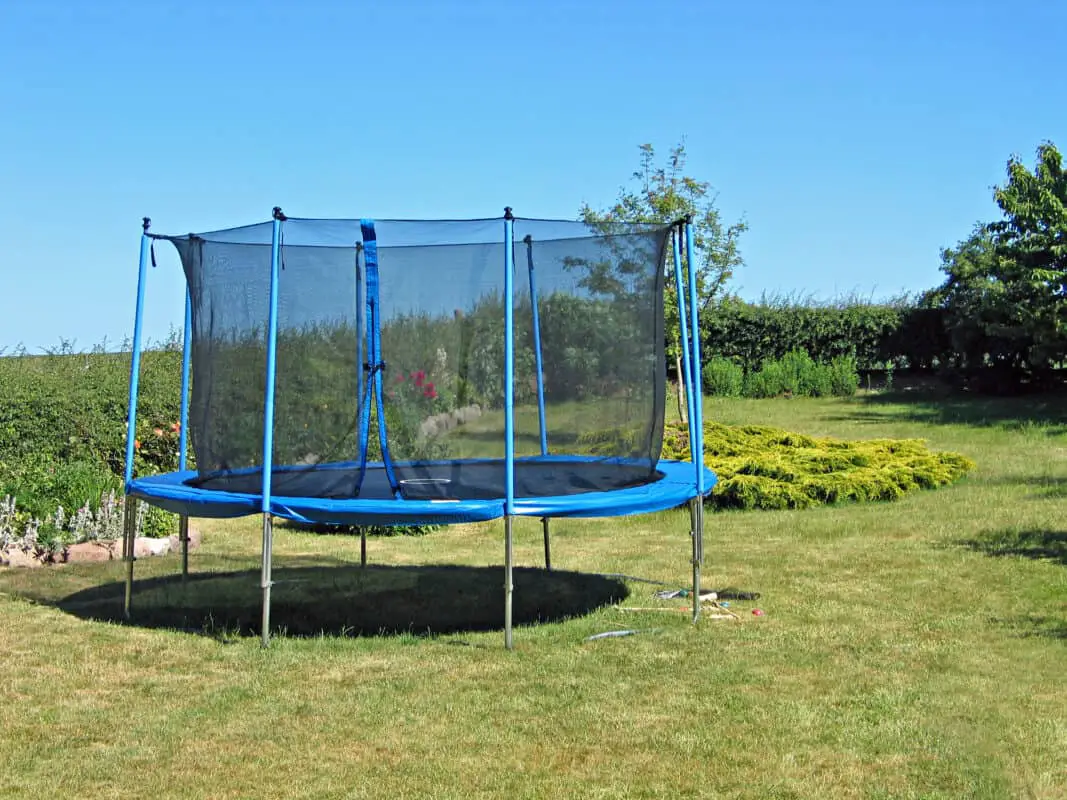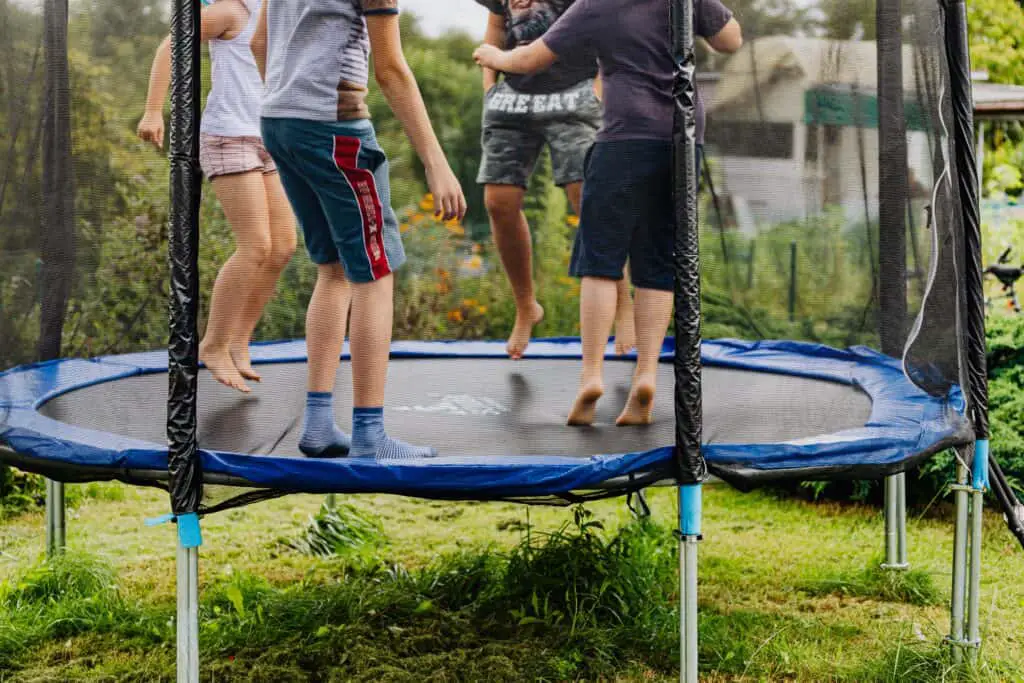Jumping on trampolines is an activity that many families, especially children, enjoy participating in together. However, having nets make trampolines safer for children. It’s a fun way to get outside and feel the rush of endorphins that jumping brings.
These endorphins can make the jumpers feel happy while getting exercise at the same time. According to statistics compiled by NBC News, approximately 100,000 injuries are caused by trampoline use each year.
These injuries range from small cuts, scrapes, and bruises, to injuries that cause damage to the head, neck, or spine, or neurological damage. Read the Mayo Clinic article regarding trampolines and children’s injuries.
Trampolining can be dangerous if not done safely. So, how can families use trampolines as safely as possible? Do safety nets help?

Related Reading: Does Jumping on a Trampoline Build Bone Density?
Benefits of How Nets Make Trampolines Safer
One of the easiest ways to increase the safety of trampolines is with safety netting. A trampoline safety net enclosure is usually made of tubes, commonly made of zinc, and a synthetic material that is woven together thickly to enhance its strength and durability.
A trampoline safety enclosure, or net, can reduce the chance of injuries by up to 50% according to CBS News, versus trampolines without nets. This gives a strong argument nets make trampolines safer.
A trampoline net safety enclosure reduces the chance that jumpers receive impact injuries, or falls off of the trampoline. Since kids, as well as adults, often lose control of themselves when jumping on a trampoline, safety nets are a critical part of the safety measures that should be put in place. Safety netting is instrumental in the prevention of falls from the trampoline.
Safety nets are designed to toss the jumper back onto the jumping surface or lower them safely to the ground beside the trampoline. Nets can help prevent jumpers from falling off of the trampoline, and over the side to the ground.
A fall like this could result in an ankle, leg, wrist, or arm injuries, or worse still…head and neck injuries. Head and neck injuries could further result in spinal injuries.
Another key to increasing the effectiveness of trampoline safety nets is making sure that the zipper or closure on the safety netting is completely closed and secured.
Most enclosures consist of zippers but are also reinforced with snap closures or heavy-duty Velcro. When excited to jump on the trampoline increases, rezipping the netting could be inadvertently forgotten.
Trampoline safety netting can help jumpers avoid bruises or burns that can be received when sliding on the netting. The softer, synthetic netting offers increased protection and more cushion for the skin when rubbing against the jumper’s skin.
[amazon box=”B005SKE9K4″ template=”widget-vertical”]
What to Look for When Choosing a Trampoline
Good safety enclosures should have several safety features that families should look for when considering the purchase of a trampoline. Trampoline enclosure poles should be gently curved, not straight, or strangely curved. Poles that are straight, or not gently curved, are more likely to be a risk to jumpers.
The mesh of the safety enclosure should also be strong, and sturdy. If you choose to leave your trampoline out in the elements all year long, both the netting and jumping surface should be made of UV-resistant material that can withstand exposure to temperature extremes.
All trampolines should be inspected frequently to ensure that there are no tears, damage, or cracks to all surfaces of the trampoline.
The mesh should be sewn onto the mat, leaving the safety pads outside of the safety enclosure. It should also be attached firmly to the enclosure.
This will help in the prevention of injuries by the jumper’s impact with metal parts, springs, or other possibly harmful parts of the trampoline. All exposed parts should have significant padding to cushion jumpers from impact.
It is also best practice to purchase a net at the same time as the trampoline, or if purchased separately, made by the same manufacturer as the trampoline.
Some Common Trampoline Injuries
Even with all safety precautions in place, injuries can and do happen. The most common trampoline injuries that occur are:
- Sprains and breaks are near the top of the list of trampoline injuries. According to the American Academy of Orthopedic Surgeons, 60 percent of fractures received on a trampoline are to the upper extremities. Approximately 36 percent of fractures are to the lower extremities.
- Burns, scrapes, and cuts are also common trampoline injuries. A friction burn, like a rug burn, may cause painful symptoms including pain, swelling, redness, or removal of the top layer of skin…aka the ‘burn’.
- Another common trampoline injury is neck injuries. Flipping and attempting tricks on a trampoline can cause injuries to the head or neck. Possible neck injuries include sprains, breaks, and in the worst-case scenarios—spinal cord injuries. Serious neck injuries can lead to paralysis and even death.
- Head injuries are trampoline injuries that should also always be taken seriously. Head or brain injuries can include closed head and traumatic brain injuries, concussions, and even brain damage. A majority of head injuries are received when jumpers jump simultaneously. In the most serious cases, major head injuries can also result in paralysis or death.
- Spinal Injuries are one of the more serious injuries that can happen while jumping on a trampoline. Many spinal injuries stem from head and neck injuries. About 20 percent of the spinal cord injuries received on a trampoline were the result of collisions with other jumpers, falling off of the trampoline, attempting tricks, or falling on the frame or springs of the trampoline.
Trampoline Safety Precautions to Take

In addition to high-quality, trampoline netting, other safety precautions should be put into place when preparing to use a trampoline.
Install safety pads to cover all springs, frames, and hooks. By padding these hard metal surfaces, children will be more protected from injuries sustained from banging into or falling on unyielding metal. Many trampoline models come with a safety pad, or they can be purchased at the same time as the trampoline.
Trampolines should be assembled on a level surface. Trampolines that are not installed on level ground increase the chance of injury to jumpers, especially children. They should be placed on a surface that is absorbing, such as grass, wood bark, or sand. Safety pads for the ground can also be purchased. This will help to cushion a jumper if they do fall off of a trampoline.
Stunts and tricks should be discouraged. Sure, trying out flips and somersaults can be loads of fun…but is not safe, when attempted on a trampoline. Because young children (and adults as well) are inexperienced when trying these moves. Attempting stunts and tricks may lead to injuries, that can range from minor to serious.
Children under six are at the greatest risk of injury and should not be allowed to use a trampoline. Young children are not developed enough, physically, to be able to control their jumping.
Supervising adults should limit jumpers to one at a time. The majority of trampoline injuries occur when more than one jumper jumps at the same time. When people are jumping together, they may bounce or knock into each other.
Things to Keep in Mind With Trampolines
All parts of the trampoline should be examined frequently for wear, any weakness, any damage from the elements, and any other outstanding safety issues that may emerge. The frame should be firmly attached to the net enclosure.
Families interested in purchasing a trampoline should do their research. By researching different options, including manufacturers, shapes, and types of trampolines, and the best enclosure nets, families can find the right fit for their situation.
The internet is a great place to research your trampoline purchase. There are many websites where people can read reviews and examine the specifications of both trampolines and trampoline enclosures. Relatives and friends with trampolines can also offer valuable information. Just remember nets make trampolines safer according to reputable safety sources.
In Conclusion
Trampolines are a great source of fun and exercise. Unfortunately, they can also be a source of injuries. Many of these injuries can be avoided or reduced by the installation of high-quality netting, and implementation of other safety measures.
